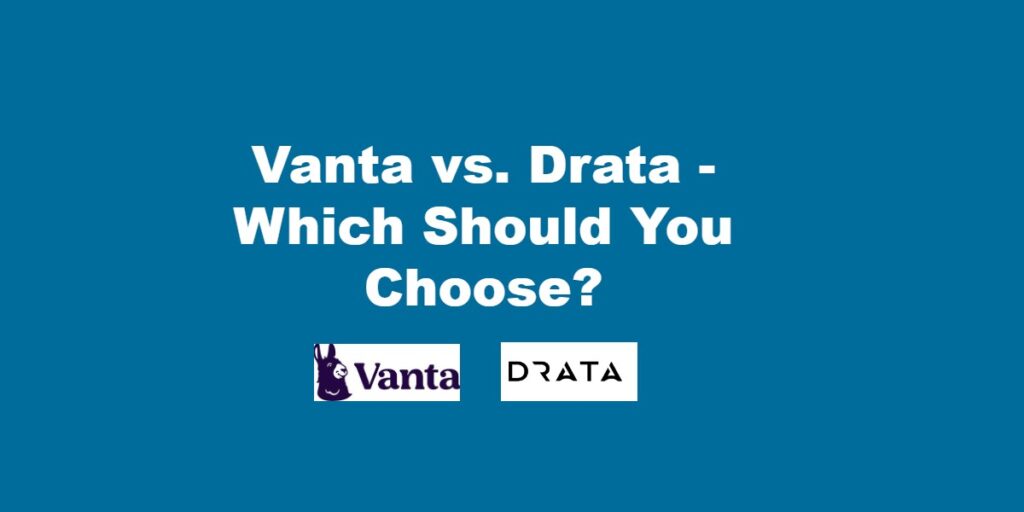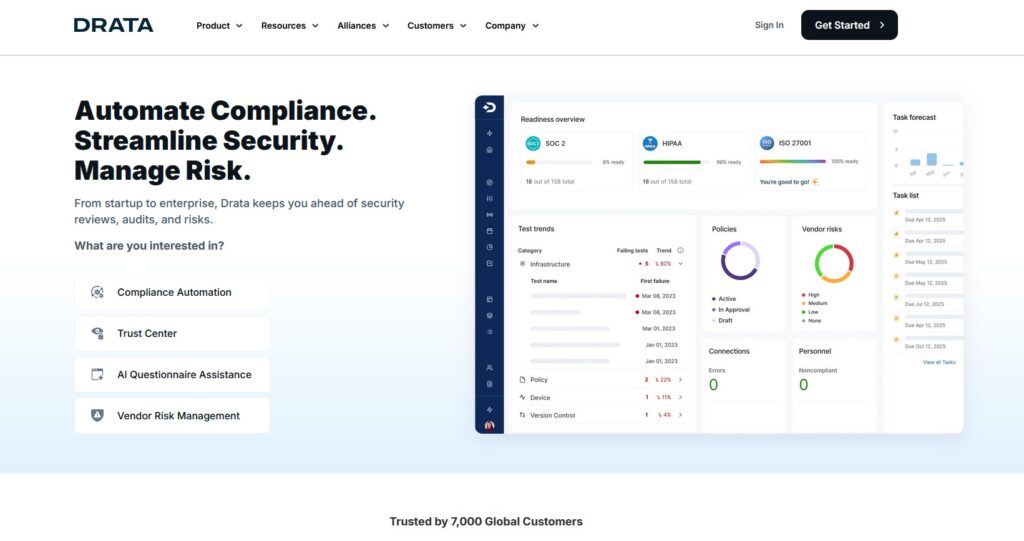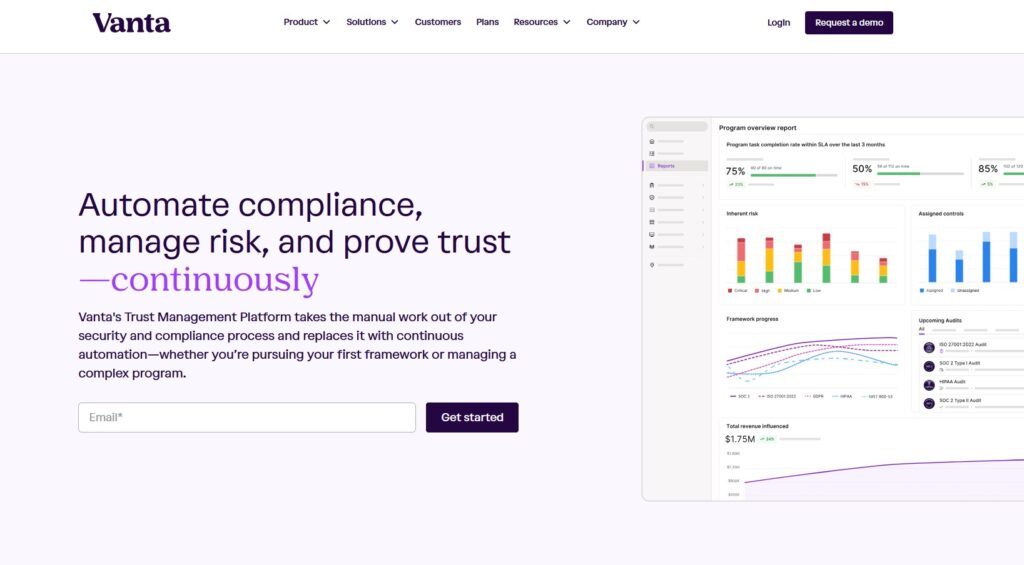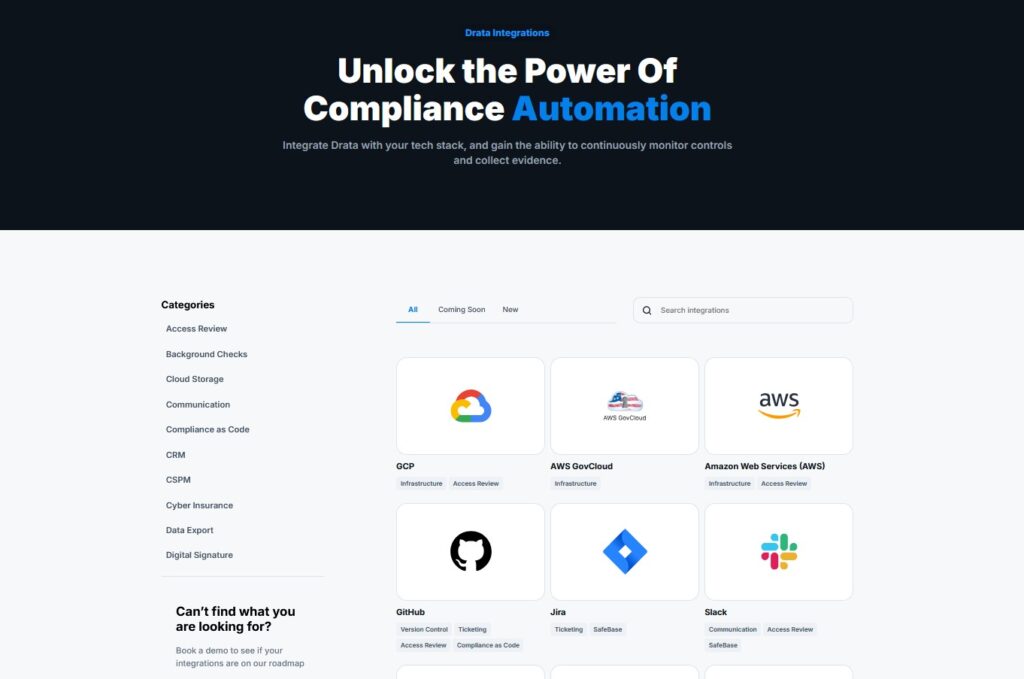From defining roles and responsibilities to establishing monitoring mechanisms and communication channels for updates, a comprehensive compliance management tool has the potential to make or break compliance with standards like HIPAA and SOC 2.
So, how do compliance management tools help companies stay audit-ready for HIPAA, SOC 2, or any other compliance framework?
Compliance frameworks are structured roadmaps guiding organizations through regulatory requirements and business objectives, fostering a culture of continual improvement. Compliance policies delineate compliance objectives and implementation strategies, instilling security and accountability. Organizations that handle Personally Identifiable Information (PII) or Protected Health Information (PHI) may have a particularly steep need for specialized assistance in achieving compliance with standards like HIPAA.
Compliance tools like Vanta and Drata work across many different frameworks and streamline policy implementation, regardless of your organization’s compliance goals. Both tools provide a solid foundation for achieving and maintaining compliance across regulatory environments. Compliance policies are one component of a compliance framework. Policies like this can help outline objectives, goals, and implementation strategies, setting benchmarks for compliance and instilling a culture of security and accountability within the organization.
Our Purpose: Comparing Vanta to Drata
These platforms offer robust solutions for seamlessly integrating various compliance frameworks, enabling organizations to navigate diverse regulatory environments with ease. Moreover, they streamline the implementation of compliance policies. This helps minimize delays, costs, and obstacles along the way. By integrating regulations and standards with organizational goals, compliance tools like Vanta and Drata offer a robust foundation for reducing incidents, and ensuring business continuity in crisis situations.
Our goal here has two parts. First, we aim to provide a general overview of Vanta and Drata’s key features, pros and cons, and target audiences. Secondly, we aim to provide a thorough overview so that we can actually help you choose between the two, if applicable. We will go so far as to make a recommendation between the two – a decision we will arrive at through a clear methodology. We hope you learn enough from what you read here to know what you don’t know a bit better, and that you can move forward and fill those knowledge gaps with confidence.
The Best Compliance Management Software: Drata vs. Vanta
In this competitive landscape, Vanta and Drata emerge as front-runners, outshining competitors like Secureframe with both their market dominance and comprehensive feature sets. Both platforms provide cost-effective solutions that enable businesses to achieve and maintain compliance without the hefty overhead costs associated with in-house compliance teams.
As today’s regulatory environment grows more complex, businesses require robust tools to maintain compliance. Vanta and Drata are the single biggest players in the space, with Secureframe in a relatively distant third. But which is the right choice for your team?
Let us delve into details and compare these software options across categories. Here are the two great compliance and risk management tools we’re reviewing today:
Drata:
Source: Drata
Drata‘s well-designed policy-building functionality and structured onboarding experience may resonate with organizations looking for a more tailored approach to compliance management. The software offers a comprehensive compliance monitoring solution suitable for startups, large enterprises, and auditors alike. Its structured onboarding and responsive support ensure swift setup. Some users report initial configuration times as short as 15 to 30 minutes.
Drata’s integration capabilities and customizable trust center provide flexibility, while pre-canned policies streamline compliance efforts, particularly for achieving SOC 2 or similar goals. Drata’s centralized document management and clear compliance roadmap enhance existing frameworks, and visible workflows make teamwork a breeze. With approximately 3,500 customers and an annual recurring revenue (ARR) of around 50 million dollars, Drata remains a key player in the compliance monitoring market.
Vanta [EDITOR’S CHOICE, Free Trial]:
Source: Vanta
Vanta stands out for its robust security automation and compliance monitoring, particularly favored among startups. Trusted by over 7,000 companies, including Flo Health and Quora, Vanta simplifies the compliance journey with automated processes and continuous monitoring. Its wide integration with various tools and systems enhances operational efficiency.
Even when accounting for some challenges like setup overhead for certain integrations and complexities in progress tracking, Vanta’s maturity and comprehensive features make it a compelling choice for navigating compliance and security in the digital landscape. With more than 7,500 customers and an ARR exceeding 100 million dollars, Vanta offers startups and enterprises alike a powerful solution for their compliance needs.
| Vanta | Drata |
|---|---|
| AI-streamlined processes | Well-designed policy building functionality |
| Pre-populated templates | Structured onboarding experience |
| Daily monitoring alerts | Comprehensive monitoring features |
| Wide integration | Minimal setup time |
We’ve personally taken a dive into all things Vanta and Drata and have gathered our findings below. Before that, though, let’s begin with a brief rundown of what we liked about each service:
Vanta (EDITOR’S CHOICE, Demo Available)
Vanta streamlines HIPAA compliance with automated policy management and customizable controls. It simplifies vendor compliance assessment and enhances security alert evidence collection. Vanta also recently expanded into questionnaire automation, further enhancing its comprehensive compliance features and expanding its offering beyond simple compliance management. While both platforms offer robust solutions for compliance management, our evaluation methodology favored Vanta overall.
Methodology:
At Planet Compliance, transparency is paramount. In this methodology section, we unveil the rigorous process behind our recommendations, offering readers clear insight into our unbiased assessments. By openly sharing our approach, we aim to build trust and confidence in our insights.
You’ll find the methodology we used to analyze these tools and their features below:
Regulatory Compliance:
A large part of evaluating software like this is the ability to gauge the software’s ability to address various regulatory requirements, such as GDPR, HIPAA, SOC 2, etc. This entails analyzing compliance features, including policy management, audit trails, and regulatory reporting capabilities, to ensure thorough regulatory adherence.
Risk Management Capabilities:
We evaluate the software’s risk management capabilities, including risk identification, assessment, mitigation, and monitoring across organizational domains. These capabilities include risk assessment templates, scoring methodologies, and integration with external risk databases.
Data Security Measures and Privacy Protection:
We assess the software’s data encryption protocols for protecting sensitive information and examine additional security features like access controls, data masking, and encryption key management. We also consider the software’s adherence to privacy regulations and best practices, such as data minimization and user consent management.
User-Friendly Setup and Interface:
We examine each user interface for friendly navigation, intuitive workflow, and accessibility for non-technical users. We consider the availability of user training resources, customer support channels, and online documentation for comprehensive user support.
Integration and Scalability:
We evaluate the software’s compatibility with existing IT infrastructure, its seamless integration with other enterprise systems, and scalability options to accommodate evolving compliance needs over time.
Vendor Support:
We spend time getting familiar with each vendor’s reputation in the compliance and risk management industry through customer reviews and analyst evaluations. Additionally, we evaluate the quality and responsiveness of support services, including technical assistance.
Cost-Effectiveness:
We analyze pricing plans and licensing models to match budgetary constraints and expected return on investment (ROI). Additionally, we scrutinize value-added features like free trials, demos, and bundled services to optimize cost-effectiveness.
Drata Review
Firstly, here is the Drata review.
Key Features:
- Comprehensive compliance monitoring
- Pre-canned policies and templates
- Structured onboarding
- Responsive customer support
- Easy, fast setup – some users report 15-30 minutes for initial configuration
- Integration with various tools
- Customizable trust center
Pros:
- Streamlined implementation process with staged onboarding steps.
- Audit-friendly templates save costs on technical writing reviews.
- Integrated approach with SaaS ecosystem reduces operational time.
- Supports multiple compliance frameworks
- Simplified infrastructure monitoring saves time in compliance audits.
- Centralized document management reduces clutter and improves accessibility.
- Provides a clear roadmap for compliance progress.
Cons:
- Limited integrations with third-party tools.
- Management of recurring tasks needs improvement for enhanced visibility.
- Complexity of features may overwhelm new users.
- Policy editor could be more user-friendly.
- Free trust center lacks configurability.
- Implementation of custom frameworks requires significant effort.
Target Audience:
Drata is tailored for medium and large startups, large enterprises, and auditors, serving a discerning audience focused on robust compliance solutions. Ideal for organizations committed to meeting compliance standards, especially SOC 2 and similar requirements, Drata is particularly suited for those prioritizing security over cost within the realm of HIPAA compliance software. Drata is aimed at enhancing existing compliance frameworks effectively, wherever the customer is in their compliance journey.
Vanta Review [EDITOR’S PICK, Free Trial, Demo]:
Here is the Vanta review.
Key Features:
- Automated compliance processes.
- Continuous monitoring for audit readiness.
- Wide integration with over 300 tools and systems.
- Pre-populated templates and automated workflows.
- Dashboard and daily monitoring alerts.
- Structured and simplified compliance understanding.
- Organized and monitored progress in compliance projects.
Pros:
- Automated processes streamline compliance tasks.
- Continuous monitoring ensures organizations remain audit-ready.
- Wide integration with various tools and systems.
- Support for multiple compliance standards tailored to specific needs.
- Automated workflows for efficient evidence collection and documentation.
- Dashboard and daily monitoring alerts provide insight into compliance status.
Cons:
- Some integrations require additional setup overhead.
- Not all services provided by integrations are fully implemented for continuous monitoring.
- Challenges in progress tracking presentation, making it difficult to estimate workload and completion time accurately.
- Improvement needed in the trustworthiness of some notification elements.
- UI may require simplification to improve initial navigation experience.
- Learning curve for new users due to extensive features.
Target Audience:
Vanta caters to businesses of all sizes seeking to simplify and centralize their security processes, with a particular emphasis on startups. Trusted by over 7,000 companies including Flo Health and Quora, Vanta automates security monitoring to ensure compliance with federal standards. Designed for companies of varying scales, Vanta stands out in the market for its maturity and comprehensive features, addressing a gap often found in similar tools.
Source: Vanta
The Best Compliance Management Tools: Drata vs. Vanta
Here is a comparison of the two best compliance management tools on the market.
- Drata vs. Vanta: Regulatory Compliance
In evaluating regulatory compliance capabilities, Vanta and Drata excel in different aspects. Vanta’s automated processes and wide integration encompass several compliance frameworks, including GDPR, HIPAA, and SOC 2. Its comprehensive features include policy management, daily monitoring alerts, and regular updates to ensure compliance with evolving regulations.
On the other hand, Drata’s strength lies in its structured onboarding and pre-canned policies, ensuring a thorough approach to compliance. While both offer robust solutions, Vanta’s broader integration and automated processes provide a more versatile approach to addressing regulatory requirements across different industries.
- Drata vs. Vanta: Risk Management Capabilities
Vanta provides automated processes for identifying, assessing, and mitigating risks, ensuring organizations remain audit-ready. It offers risk assessment templates and a structured approach to risk scoring methodologies, enhancing its effectiveness in managing risks across various organizational domains. Additionally, Vanta’s integration with external risk databases further enhances its ability to monitor risks comprehensively.
Drata focuses more on streamlining risk management through a very in-depth onboarding process and pre-canned policies. While it may not offer the same level of automation or integration capabilities as Vanta, Drata’s approach ensures a thorough and structured assessment of risks.
Ultimately, the choice between Vanta and Drata in terms of risk management capabilities depends on the organization’s preference for an automated versus manually structured approach to risk assessment and mitigation.
- Drata vs. Vanta: Data Security and Privacy Measures
Vanta employs strong data encryption protocols to safeguard sensitive information, ensuring comprehensive security across its platform. It offers additional security features such as access controls, data masking, and encryption key management, enhancing overall data protection measures.
Drata’s offering emphasizes data security as well, featuring robust encryption protocols to protect sensitive information from unauthorized access. By implementing these measures, both Vanta and Drata ensure that users can trust their platforms with confidential data and maintain compliance with stringent security standards.
- Drata vs. Vanta: Ease of Use and Support
Based on user reviews, Vanta seems to have a more intuitive interface, offering straightforward navigation and user-friendly features. That said, Drata’s white-glove customer support makes it unlikely that users will lose a lot of time to less-than-intuitive tools in their compliance management stack. Both Vanta and Drata prioritize user-friendliness and robust customer support.
Vanta offers an intuitive user interface designed for easy navigation and a seamless workflow, catering to both technical and non-technical users alike. It provides comprehensive training resources, including tutorials, documentation, and customer support channels, ensuring users have the necessary assistance to navigate the platform effectively.
Drata has also invested in a user-friendly experience. The tool features an intuitive interface that facilitates easy navigation and accessibility for all users. It also offers readily available customer support channels to assist users in maximizing their experience with the platform. Customer feedback that the tool can be confusing to use at first is often balanced by glowing feedback on their very helpful customer support.
- Drata vs. Vanta: Compatibility and Integration
Vanta boasts over 300 native integrations, providing extensive compatibility with various IT infrastructure and enterprise systems. This wide array of integrations facilitates seamless connectivity and automation for compliance processes, enhancing efficiency and productivity.
Drata provides around 120 integrations, offering a limited selection when compared to Vanta. Drata still provides essential compatibility with existing IT infrastructure and enterprise systems, and compensates for the shortage with robust scalability options that accommodate growth and evolving compliance needs over time.
Source: Drata
- Drata vs. Vanta: Vendor Reputation and Support
Vanta’s compliance platform boasts a strong reputation in the compliance and risk management sector, backed by positive customer reviews and analyst evaluations. Its support services are characterized by high-quality technical assistance and regular software updates, ensuring customers receive reliable and responsive support.
Drata maintains a solid standing in the compliance and risk management industry. Its support services are known for their quality and responsiveness, providing customers with efficient technical assistance and timely software updates. That said, Drata’s reputation is slightly marred (in this writer’s opinion, at least) by its engagement in negative smear campaign-like advertising targeted at competitor, Vanta (whose mascot is a purple llama).
- Drata vs. Vanta: Pricing and Value
Vanta’s pricing starts at $7,500 for 1-20 employees, with customizable packages like the Vanta Framework, Core Package, Collaborate Package, and Scale Package to meet various organizational needs and budgets.
Drata’s pricing ranges from $20,000 to $100,000, depending on factors like company size and selected compliance framework. While Drata may be pricier than similar tools, it garners praise for its fast implementation and comprehensive customer support. Additionally, Drata’s auditor-agnostic platform does set it apart from competitors with limited auditor partnerships.
THE WINNER: Vanta
While Drata offers wonderfully structured onboarding and comprehensive monitoring, Vanta emerged as the preferred choice based on our methodology. Ultimately, while both platforms offer robust solutions, Vanta emerges as the preferred choice. The decision between them hinges on organizational needs, such as integration flexibility, user interface preferences, pricing, and overall accessibility of support services. Vanta stood out for its wide integration and user-friendly interface.
Vanta excels in regulatory compliance with its automated processes, wide integration capabilities, and support for multiple standards. Its comprehensiveness goes a long way toward ensuring organizations remain compliant with evolving regulations. Additionally, Vanta’s streamlined risk management approach, coupled with its extensive integration options, enhances its effectiveness in mitigating risks across different organizational domains.
Vanta’s more comprehensive integrations, option for automated processes, and intuitive interface make it a more versatile and user-friendly choice for efficient compliance management. Ultimately, Vanta’s impressive performance across our evaluation criteria positions it as the preferred option for navigating compliance complexities effectively.






